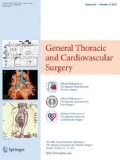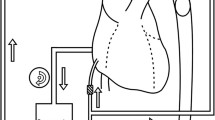Abstract
In the absence randomized data for assessing the best and optimal temperature for managing open aortic arch surgery patients, cerebral protection method is still performed through hypothermic circulatory arrest with or without the use of adjuncts. A recent consensus has emerged setting to define the temperature levels. In an attempt, this was aimed to establish a solid ground for future trials in aortic arch surgery. This article reviews the current literature and the evidences behind using different temperature methods and their outcomes in patients undergoing open aortic arch surgery.
Similar content being viewed by others
References
Ziganshin BA, Elefteriades JA. Deep hypothermic circulatory arrest. Ann Cardiothorac Surg. 2013;2:303–15.
DeBakey ME, Crawford ES, Cooley DA, Morris GC Jr. Successful resection of fusiform aneurysm of aortic arch with replacement by homograft. Surg Gynecol Obstet. 1957;105:657–64.
Griepp RB, Stinson EB, Hollingsworth JF, Buehler D. Prosthetic replacement of the aortic arch. J Thorac Cardiovasc Surg. 1975;70(6):1051–63.
Al Kindi AH, Al Kimyani N, Alameddine T, Al Abri Q, Balan B, Al Sabti H. “Open” approach to aortic arch aneurysm repair. J Saudi Heart Assoc. 2014;26(3):152–61. https://doi.org/10.1016/j.jsha.2014.02.006.
Bachet J, Guilmet D, Goudot B, Dreyfus GD, Delentdecker P, Brodaty D, et al. Antegrade cerebral perfusion with cold blood: a 13-year experience. Ann Thorac Surg. 1999;67:1874–8 (discussion 91–4).
Kazui T, Washiyama N, Muhammad BA, Terada H, Yamashita K, Takinami M, et al. Total arch replacement using aortic arch branched grafts with the aid of antegrade selective cerebral perfusion. Ann Thorac Surg. 2000;70:3–8 (discussion 8–9).
Bachet J, Guilmet D, Goudot B, Termignon JL, Teodori G, Dreyfus G, et al. Cold cerebroplegia. A new technique of cerebral protection during operations on the transverse aortic arch. J Thorac Cardiovasc Surg. 1991;102:85–93 (discussion 93–4).
Englum BR, Andersen ND, Husain AM, Mathew JP, Hughes GC. Degree of hypothermia in aortic arch surgery – optimal temperature for cerebral and spinal protection: deep hypothermia remains the gold standard in the absence of randomized data. Ann Cardiothorac Surg. 2013;2(2):184–93. https://doi.org/10.3978/j.issn.2225-319X.2013.03.01.
Yan TD, Tian DH, LeMaire SA, et al. The ARCH Projects: Design and rationale (IAASSG 001). Eur J Cardiothorac Surg. 2014;45:10–6.
Shuhaiber JH. Evaluating the quality of trials of hypothermic circulatory arrest aortic surgery. Asian Cardiovasc Thorac Ann. 2007;15:449–52.
Augoustides JG. What are the clinical questions for the optimal conduct of deep hypothermic circulatory arrest for adult aortic arch repair? J Cardiothorac Vasc Anesth. 2007;21:918–9.
Urbanski PP, Lenos A, Bougioukakis P, Neophytou I, Zacher M, Diegeler A. Mild-to-moderate hypothermia in aortic arch surgery using circulatory arrest: a change of paradigm? Eur J Cardiothorac Surg. 2012;41:185–91.
Leshnower BG, Myung RJ, Kilgo PD, Vassiliades TA, Vega JD, Thourani VH, et al. Moderate hypothermia and unilateral selective antegrade cerebral perfusion: a contemporary cerebral protection strategy for aortic arch surgery. Ann Thorac Surg. 2010;90:547–54.
Zierer A, Detho F, Dzemali O, Aybek T, Moritz A, Bakhtiary F. Antegrade cerebral perfusion with mild hypothermia for aortic arch replacement: single-center experience in 245 consecutive patients. Ann Thorac Surg. 2011;91:1868–73.
Luehr M, Bachetb J, Mohra FW, Etza CD. Modern temperature management in aortic arch surgery: the dilemma of moderate hypothermia. Eur J Cardiothorac Surg. 2014;45:27–39.
Baumgartner WA, Owens SG, Cameron DE, Reitz BA. The Johns Hopkins manual of cardiac surgical care. St. Louis: Mosby; 1994.
Ehrlich MP, McCullough JN, Zhang N, Weisz DJ, Juvonen T, Bodian CA, et al. Effect of hypothermia on cerebral blood flow and metabolism in the pig. Ann Thorac Surg. 2002;73:191–7.
Stecker MM, Cheung AT, Pochettino A, et al. Deep hypothermic circulatory arrest I: effects of cooling on electroencephalogram and evoked potentials. Ann Thorac Surg. 2001;71:14–21.
Ml Andersen J, Swaminathan ND. M, et al.: Predictors of electrocerebral silence with deep hypothermia. J Thorac Cardiovasc Surg. 2014;14:1002–7.
Angeloni E, Benedetto U, Takkenberg JJ, et al. Unilateral versus bilateral antegrade cerebral protection during circulatory arrest in aortic surgery: a meta-analysis of 5100 patients. J Thorac Cardiovasc Surg. 2014;147:60–7.
Tian DH, Wan B, Bannon PG, et al. A meta-analysis of deep hypothermic circulatory arrest alone versus with adjunctive selective antegrade cerebral perfusion. Ann Cardiothorac Surg. 2013;2:261–70.
Svensson LG, Blackstone EH, Rajeswaran J, et al. Does the arterial cannulation site for circulatory arrest influence stroke risk? Ann Thorac Surg. 2004;78:1274–84 (discussion 1274-84).
Gega A, Rizzo JA, Johnson MH, et al. Straight deep hypothermic arrest: experience in 394 patients supports its effectiveness as a sole means of brain preservation. Ann Thorac Surg. 2007;84:759–66 (discussion 766–7).
Milewski RK, Pacini D, Moser GW, et al. Retrograde and antegrade cerebral perfusion: results in short elective arch reconstructive times. Ann Thorac Surg. 2010;89:1448–57.
Lima B, Williams JB, Bhattacharya SD, et al. Results of proximal arch replacement using deep hypothermia for circulatory arrest: is moderate hypothermia really justifiable? Am Surg. 2011;77:1438–44.
Leshnower BG, Myung RJ, Kilgo PD, et al. Moderate hypo- thermia and unilateral selective antegrade cerebral perfusion: a con- temporary cerebral protection strategy for aortic arch surgery. Ann Thorac Surg. 2010;90:547–54.
Leshnower BG, Myung RJ, Thourani VH, et al. Hemiarch replacement at 28 degrees Celsius: an analysis of mild and moderate hypothermia in 500 patients. Ann Thorac Surg. 2012;93:1910–5.
Gutsche JT, Feinman J, Silvay G, et al. Practice variations in the conduct of hypothermic circulatory arrest for adult aortic arch repair: Focus on an emerging European paradigm. Heart Lung Vessels. 2014;6:43–51.
Pacini D, Di Marco L, Leone A, et al. Antegrade selective cerebral perfusion and moderate hypothermia in aortic arch surgery: Clinical outcomes in elderly patients. Eur J Cardiothorac Surg. 2012;42:249–53.
Kamiya H, Hagl C, Kropivnitskaya I, et al. The safety of moderate hypothermic lower body circulatory arrest with selective cerebral perfusion: a propensity score analysis. J Thorac Cardiovasc Surg. 2007;133:501–9.
Khaladj N, Shrestha M, Meck S, et al. Hypothermic circulatory arrest with selective antegrade cerebral perfusion in ascending aortic and aortic arch surgery: a risk factor analysis for adverse outcome in 501 patients. J Thorac Cardiovasc Surg. 2008;135:908 – 14.
Zierer A, Detho F, Dzemali O, et al. Antegrade cerebral perfusion with mild hypothermia for aortic arch replacement: single-center experience in 245 consecutive patients. Ann Thorac Surg. 2011;91:1868–73.
Leshnower BG, Thourani VH, Halkos ME, et al. Moderate versus deep hypothermia with unilateral selective antegrade cerebral perfusion for acute type A dissection. Ann Thorac Surg. 2015;100:1563–8 (discussion 1568–9).
Mazzeffi M, Marotta M, Lin HM, et al. Duration of deep hypothermia during aortic surgery and the risk of perioperative blood transfusion. Ann Card Anaesth. 2012;15:266–73.
Harrington DK, Lilley JP, Rooney SJ, et al. Nonneurologic morbidity and profound hypothermia in aortic surgery. Ann Thorac Surg. 2004;78:596–601.
Cooper WA, Duarte IG, Thourani VH, et al. Hypothermic circulatory arrest causes multisystem vascular endothelial dysfunction and apoptosis. Ann Thorac Surg. 2000;69:696–702 (discussion 703).
Hagl C, Tatton NA, Khaladj N, et al. Involvement of apoptosis in neurological injury after hypothermic circulatory arrest: a new target for therapeutic intervention? Ann Thorac Surg. 2001;72:1457–64.
Gong M, Ma WG, Guan XL, Wang LF, Li JC, Lan F, Sun LZ, Zhang HJ. Moderate hypothermic circulatory arrest in total arch repair for acute type A aortic dissection: clinical safety and efficacy. J Thorac Dis. 2016;8(5):925–33. https://doi.org/10.21037/jtd.2016.02.75.
Zierer A, El-Sayed Ahmad A, Papadopoulos N, et al. Selective antegrade cerebral perfusion and mild (28–30 degrees Celsius) systemic hypothermic circulatory arrest for aortic arch replacement: results from 1002 patients. J Thorac Cardiovasc Surg. 2012;144:1042–50.
Legras A, Bruzzi M, Nakashima K, et al. Colder is better during hypothermic circulatory arrest for acute type an aortic dissection. Scand Cardiovasc J. 2013;47:121–8.
Di Eusanio M, Wesselink RM, Morshuis WJ, et al. Deep hypothermic circulatory arrest and antegrade selective cerebral perfusion during ascending aorta-hemiarch replacement: a retrospective comparative study. J Thorac Cardiovasc Surg. 2003;125:849–54.
Zierer A, Risteski P, El-Sayed Ahmad A, et al. The impact of unilateral versus bilateral antegrade cerebral perfusion on surgical outcomes after aortic arch replacement: a propensity-matched analysis. J Thorac Cardiovasc Surg. 2014;147:1212–8.
Spielvogel D, Kai M, Tang GH, Malekan R, Lansman SL. Selective cerebral perfusion: a review of the evidence. J Thorac Cardiovasc Surg. 2013;145(3Suppl):S59–62. https://doi.org/10.1016/j.jtcvs.2012.11.073 (Epub 2012 Dec 22. Review).
Spielvogel D, Tang GHL. Selective cerebral perfusion for cerebral protection: what we do know. Ann Cardiothorac Surg. 2013;2(3):326–30. https://doi.org/10.3978/j.issn.2225-319X.2013.03.02.
Ergin MA, Galla JD, Lansman, sL, et al. Hypothermic circulatory arrest in operations on the thoracic aorta. Determinants of operative mortality and neurologic outcome. J Thorac Cardiovasc Surg. 1994;107:788–97 (discussion 797–9).
Matalanis G, Koirala RS, Shi WY, Hayward PA, McCall PR. Branch-first aortic arch replacement with no circulatory arrest or deep hypothermia. J Thorac Cardiovasc Surg. 2011;142(4):809–15. https://doi.org/10.1016/j.jtcvs.2011.01.020 (Epub 2011 Feb 16).
Matalanis G, Galvin SD. “Branch-first” continuous perfusion aortic arch replacement and its role in intra-operative cerebral protection. Ann Cardiothorac Surg. 2013;2(2):194–201. https://doi.org/10.3978/j.issn.2225-319X.2013.02.01.
Galvin SD, Matalanis G. Continuous perfusion “Branch-first” aortic arch replacement: a technical perspective. Ann Cardiothorac Surg. 2013;2(2):229–34. https://doi.org/10.3978/j.issn.2225-319X.2013.03.04.
Brinster DR. Simplified technique of total aortic arch replacement with minimal circulatory and myocardial ischemia. Ann Thorac Surg. 2012;94(3):e83–5. https://doi.org/10.1016/j.athoracsur.2012.05.094.
Kent WD, Wong JK, Herget EJ, Bavaria JE, Appoo JJ. An alternative approach to diffuse thoracic aortomegaly: on-pump hybrid total arch repair without circulatory arrest. Ann Thorac Surg. 2012;93(1):326–8. https://doi.org/10.1016/j.athoracsur.2011.08.051.
Kent WD, Herget EJ, Wong JK, Appoo JJ. Ascending, total arch, and descending thoracic aortic repair for acute DeBakey type I aortic dissection without circulatory arrest. Ann Thorac Surg. 2012;94(3):e59–61.
Appoo JJ, Tse LW, Pozeg ZI, Wong JK, Hutchison SJ, Gregory AJ, Herget EJ. Thoracic aortic frontier: review of current applications and directions of thoracic endovascular aortic repair (TEVAR). Can J Cardiol. 2014;30(1):52–63. https://doi.org/10.1016/j.cjca.2013.10.013 (Epub 2013 Oct 24. Review).
Szeto WY, Bavaria JE. Hybrid repair of aortic arch aneurysms: combined open arch reconstruction and endovascular repair. Semin Thorac Cardiovasc Surg Winter. 2009;21(4):347–54. https://doi.org/10.1053/j.semtcvs.2009.11.007 (Review).
Bavaria J, Milewski RK, Baker J, Moeller P, Szeto W, Pochettino A. Classic hybrid evolving approach to distal arch aneurysms: toward the zone zero solution.J Thorac Cardiovasc Surg. 2010;140(6 Suppl):S77–80. https://doi.org/10.1016/j.jtcvs.2010.07.031 (discussion S86–91).
Author information
Authors and Affiliations
Corresponding author
Ethics declarations
Conflict of interest
There are no conflicts of interest or sources of support.
Rights and permissions
About this article
Cite this article
Harky, A., Bashir, M. & Mariscalco, G. Aortic arch aneurysm surgery: what is the gold standard temperature in the absence of randomized data?. Gen Thorac Cardiovasc Surg 67, 127–131 (2019). https://doi.org/10.1007/s11748-017-0867-9
Received:
Accepted:
Published:
Issue Date:
DOI: https://doi.org/10.1007/s11748-017-0867-9




